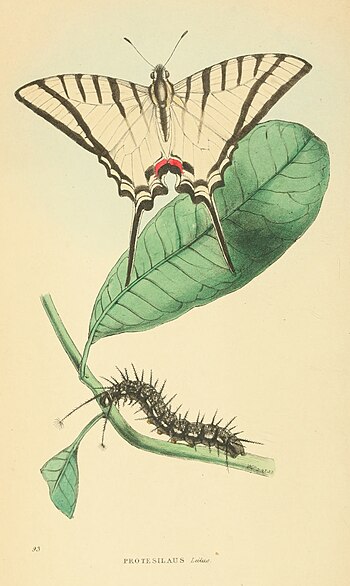PROTESILAUS Leilus.
From the resemblance which this insect bears to the rare British species, named by collectors the scarce Swallow-tail, (Papilio Podalirius,) it is generally called the Brazilian Swallow-tail. We advert to this circumstance, trivial as it may sound to scientific ears, first because it is one of the many proofs in which the nomenclature of the vulgar conveys greater information than that of the professor: and secondly, because these very names, in numberless instances, imply a perception of natural analogies, which, without the labour of philosophic research, suggest themselves to unscientific observers. In the present instance, these facts may be verified in the most unquestionable manner. According to our views, Protesilaus not only represents one of the primary groups of the Lepidoptera, but also typifies the Fissirostral birds, of which the swallows are the most pre-eminent.
PROTESILAUS Leilus,
Protesilaus Butterfly.
Genus Amphrisius, Sw. Sub-genus Protesilaus, Sw.
Sub-generic Characters.
Wings trigonal, acute, yellow with black transverse bands; the inferior lengthened, narrowed, with two long acute tails; antennæ short, the club thick, slightly compressed, but solid, and convex all round; front very hairy; Larva covered with sharp spines. Pupa braced, but suspended downwards.
Type, Pap. Protesilaus. Auct.
Specific Character.
Wings straw-colour; the superior with four, short, black, costal bands towards the base, and two towards the exterior margin; the latter uniting at the posterior angle.
Pap. Protesilaus. Lin. Fab. Ent. Sys. 3. pl. p. 23. Ency. Meth. p. 50. Merian Sur. pl. 43. Cramer, pl. 202. f. a. b.
Madam Merian's valuable work on the Insects of Surinam, has furnished us with a figure of the larva; which, unlike that of the European Swallow-tails, is covered with spines: the chrysalis also departs from the usual type of the family, in having the head directed downwards. These facts we have verified by an inspection of the original drawings, of M. Merian, now deposited in the British Museum. These are all important variations in structure, which can only be explained by the natural system.
